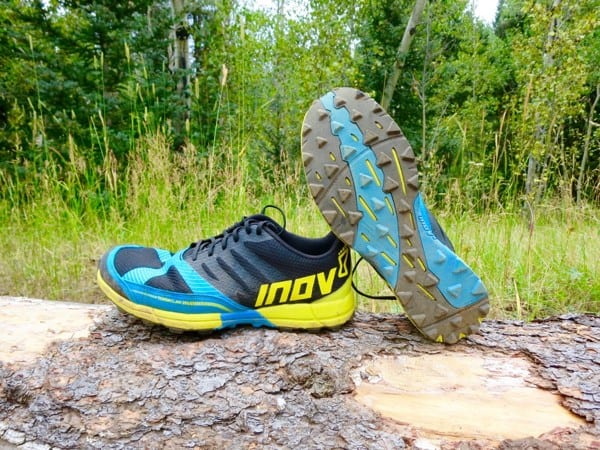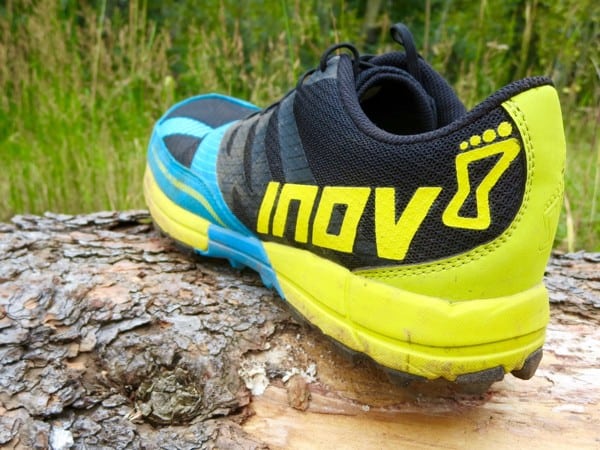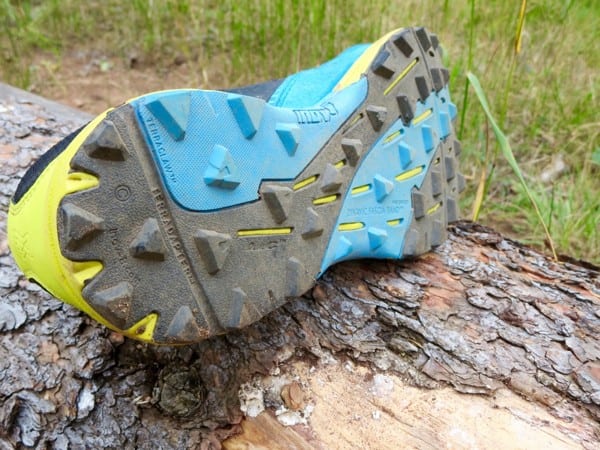Our Favorite Trail Running Shoes
Check out our Best Trail Running Shoes article to learn about our current favorite trail running shoes!
Inov-8 Terraclaw 250 Review
The arrival of the shoulder season has many trail and ultrarunners longing for cooler temperatures, fall foliage, and for some, a return to shorter, more intense racing in the elements of cross-country running. How fitting to mark this transition into autumn with a review of the Inov-8 Terraclaw 250 ($130), the newest well-lugged traction monster from Inov-8. There are a number of differences between the Terraclaw and other offerings from Inov-8, a company which practically dominates the fell-running scene in the U.K. Primarily, this shoe was designed for hard-packed, rocky terrain, rather than the muddy bogs I initially imagined it had been designed for. Additionally, the Terraclaw 250 replaces the Trailroc offerings in the Inov-8 line which was also designed for hard pack (more on my thoughts about this change below). So, let’s delve into an unnecessarily thorough critique of a fairly simple trail running shoe.

The Inov-8 Terraclaw 250.
Upper
The Terraclaw 250 features the same accommodating fit that most Inov-8 models have gravitated toward lately. A moderately snug heel cup gradually widens toward a generous toe box which is toe-box shaped without being clown-shoe sloppy. Inov-8’s typically low heel collar, which I generally really enjoy, provided some discomfort on this particular model. However, I think that the ensuing blistering on the back of my heel was particular to my feet, and other runners I’ve spoken with do not have such an issue. The rest of the upper fit manages to be designed well for technical running, feeling fairly low-profile and locked down without feeling restrictive.
The Terraclaw’s mesh upper is one of the most durable upper fabrics I’ve seen on a running shoe. After over 200 miles of use on burly terrain, the mesh doesn’t show any signs of snags, abrasions, or use at all really. This durability is reinforced by a synthetic leather rand and toecap around the front half of the shoe which alleviates any bruised toes or pokes into the mesh by offending rocks. Overlays on the Terraclaw seem largely cosmetic, however after several runs I was impressed by the welded-on X-Lock overlays across the toe box which seem to prohibit a roomy toe box from feeling sloppy.

The Inov-8 Terraclaw 250 lateral upper.
Midsole
The Terraclaw 250 uses a fairly generous amount of compressed EVA throughout the midsole, providing a familiar, firm ride for Inov-8 indoctrinates. The compressed nature of the EVA seems to improve durability, however I found the Terraclaw 250 to feel a bit dead on hard pack. Most of the forgiveness in this shoe seems to come from the approximately 4mm lugs on the outsole. The fairly flat and unresponsive feeling of this shoe on hard trails was completely redeemed when running on soft-ground conditions including sand and mud. In fact, it wasn’t until after several weeks of testing the Terraclaw that I read the promotional materials and realized that the sloppy conditions I’d been wearing them in were contrary to what they were designed for.
Although the Terraclaw is a neutral shoe, some stability is provided by Hard Sticky rubber which runs across the middle of the outsole, as well as the relatively low stack height. With an 8mm heel drop, this shoe has a bit steeper ramp than any Inov-8 model I’ve run in, and I’d assumed 3 to 4mm during my first several runs. While this wasn’t a deterrent in any way from the shoe’s performance, it seems odd to me that Inov-8 is now creating shoes with a more moderate heel drop (Race Ultra 290), rather than sticking with what initially brought them popularity in their line which was low-drop shoes with incredible traction. At 9 ounces for my men’s size 10, the unforgiving midsole didn’t exactly warrant the extra weight either.

The Inov-8 Terraclaw 250 medial upper.
Outsole
Inov-8 uses a combination of Soft Sticky Rubber and Hard Sticky Rubber throughout the outsole, and both are aptly named. This shoe provides fantastic traction in really any conditions, but preferably those that are wet and muddy. The Terraclaw also grips dry rock well and does well when scrambling is required. While a rock plate is not present, the outsole and midsole combo tend to be firm enough to absorb the potential damage from most rocks, however I did experience some rocks poking through on rocky downhill terrain.
As stated before, I don’t believe that the Terraclaw is best used as a hard-surface trail shoe, and it seemed to perform best in shedding med and wet clay. The well-spaced lugs free themselves quickly from any sloppy terrain and seem to bite well in soupy conditions.

The Inov-8 Terraclaw 250 outsole.
Overall Impressions
Inov-8 has chosen to discontinue their fairly popular (at least in the western U.S.) Trailroc series of trail running shoes, which were designed for hard surfaces, in favor of the Terraclaw series which have a firmer midsole and are more heavily lugged. While I can understand the motivation for Inov-8 to pair down the offerings in their trail-shoe line, I really believe that these two lines of shoes are completely different animals. On true hard and rocky surfaces common in the western U.S., the Terraclaw feels a bit too firm and heavily lugged which lends to an off-camber feel. However, the Trailroc 245 ate up this terrain and also seemed to assuredly handle the slop. Additionally, the Trailroc series featured a rock plate which makes a lot of difference in the ultra distances on truly technical terrain.
Now understand, while I’d love Inov-8 to salvage the Trailroc series, I do not wish to denigrate the positive qualities of the Terraclaw 250. This is a fantastic soft-ground trail shoe which I’d wear for up to 50k in sloppy conditions. The fit is fantastic, it bites well in most conditions, and the compressed midsole EVA offers just enough forgiveness to handle ultra distances. But, it would be the last shoe in my arsenal I’d select for an ultra-distance race on dry, packed trails. Furthermore, the Terraclaw 250 seems to be more closely related in design to the X-Talon series than any shoe made for hard-pack trails in the Inov-8 line. I would recommend this shoe for runners entering the fall cross-country and trail season expecting a bit of slop, where a workhorse trail shoe will continue to be useful throughout the winter months.
